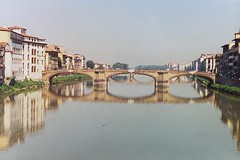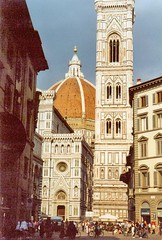In today's post, I am fulfilling a promise made several weeks ago to Cindy Madsen. Because I know she does not spend much time on the Internet, I will leave it to Barney to make sure this gets to her.
During my trip to Utah several weeks ago, I had two occasions to make some of my Tuscan bean and rice soup, both of which are recounted in
this post. I promised Cindy that I would send her the recipe, adding that I had thought of sending it to her long before, but decided to wait until after I could visit Utah again myself and prepare it for one of the Madsens' post-General Conference get-togethers. In other words, I wanted to introduce it to them myself, in person; and last month, I finally had my chance.
I do not claim to be one of the world's great cooks, but my culinary efforts have generally tended to be quite successful. Deep down inside, I must have some sort of artistic bent, which perhaps manifests itself whenever I try to cook something -- at least, when I cook something on
my terms. My wife would tell you that if she asks me to fix some macaroni and cheese for our kids, I'll balk at the idea; but that on the other hand, if she asks me to slave over a hot stove for several hours, making some Hungarian paprika chicken, I'll tackle the project with gusto. There is nothing creative, after all, about a box of Kraft macaroni and cheese -- and besides, would someone such as Dante ever have eaten it? (Then again, during his exile, perhaps he would have. In
Paradiso XVII:58-60, his ancestor Cacciaguida voices the dark prophecy that he, Dante, "will come to know how bitter as salt and stone is the bread of others," so perhaps even Kraft macaroni and cheese would have been better than some of the other components of his diet -- at least until he came to Ravenna and fell under the protection of Guido da Polenta.) Not surprisingly, my own favorite cuisine is Italian, followed by Chinese, Greek, and Mexican. The only one of the four national cuisines in which I have ever seriously dabbled, however, is the Italian.
One of my favorite books is
Dante in Love, by Harriet Rubin. On page 233 of the hardbound edition, she has this to say:
"Waverly Root in The Food of Italy
asks, 'Does a well-fed race produce more geniuses than others?' Perhaps he was thinking of all the explorers, artists, musicians, and strategists raised on Italian plenty. Even America has an Italian name, We ourselves are nouveau Romans. So, did Dante eat well? More than a bit of beef and a sip of wine? Did all the sweetness he sought come from the endless rhymes in his mouth? Dante presumably tasted Paradise in Ravenna as nowhere else. Guido was a generous host, and Ravenna is an ocean of feast: hogfish, eel, lemon sole, grey mullet, red mullet, dogfish, squill, calamari
and mazzole
. The Pineta', the pine forest, yielded pine nuts for desserts; the shells added fragrance to fires."With that in mind, I discovered this recipe in an Italian cooking magazine about 18 months ago, and immediately fell in love with it. I especially like to prepare it for occasions when we have company. I also like to fancy that perhaps Dante himself ate this during his day, although I know that is impossible, because tomatoes were not eaten in Italy until about the 16th century. (Apparently people had theretofore regarded them with superstitious dread, because the core of a tomato bears some resemblance to the cross.) Whether he ate this soup or not, it is available for all of us to enjoy in our time, and has the advantages of being highly nutritious and very easy to prepare. And creative, of course. The only problem with it is that three days or so after you eat this stuff, you may start to get hungry again, as it is quite filling.
So here it is. This recipe will yield 6 servings, but I nearly always multiply the ingredients by three and make a large batch. This takes me about an hour and a half to prepare, and it tends to go quickly. I recommend serving it with Italian bread.
Ingredients:8 oz. Italian sausage (preferably spicy)
3 (16 oz.) cans of low-sodium chicken broth
1 (28 oz.) can of diced tomatoes
1/2 teaspoon salt
1/4 teaspoon freshly-cracked black pepper
1/4 teaspoon dried oregano
1 cup uncooked rice
1 (15-1/2 oz.) can of Great Northern or pinto beans, drained and rinsed (I personally prefer it with pinto beans, although I have prepared it both ways).
Preparation:Brown sausage in a 3- to 4-quart saucepan over medium high heat for about 6 minutes, then drain fat. Stir in broth, tomatoes, salt, pepper and oregano; bring to a boil. Stir in the rice and beans. Cover and simmer for about 15 to 20 minutes, or until the rice is fully cooked. Serve immediately -- and with Italian bread, as I recommended above.
Try this, and let me know what you think of it. I predict that you will want to make it again and again.





